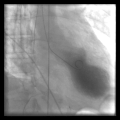Cardiac catheterization
| Pronunciation | |
|---|---|
| Other names | |
| Specialty | |
| Uses | |
| Complications | |
| Approach | |
| Types | |
| Recovery time | |
| Other options | |
| Frequency |
Cardiac catheterization is a medical procedure used to diagnose and treat certain cardiovascular conditions. During this procedure, a long thin tube called a catheter is inserted in an artery or vein in your groin, neck, or arm and threaded through your blood vessels to your heart.
Indications[edit]
Cardiac catheterization is used to investigate and treat a variety of heart conditions, including:
Procedure[edit]
The procedure is typically performed in a catheterization laboratory (cath lab) by a cardiologist and a specialized team of nurses and technicians. The patient is usually awake but sedated, and local anesthesia is applied to the insertion site.
Steps[edit]
1. **Preparation**: The patient is prepared and the insertion site is cleaned and numbed. 2. **Insertion**: A sheath is inserted into the blood vessel. 3. **Catheterization**: The catheter is guided through the blood vessels to the heart using fluoroscopy. 4. **Diagnosis and Treatment**: Various tests and treatments can be performed, such as angiography, angioplasty, or stent placement. 5. **Completion**: The catheter and sheath are removed, and pressure is applied to the insertion site to prevent bleeding.
Risks[edit]
While cardiac catheterization is generally safe, it does carry some risks, including:
Recovery[edit]
After the procedure, patients are monitored for several hours. They may need to lie flat for a few hours to prevent bleeding from the insertion site. Most patients can return to normal activities within a few days.
See also[edit]
References[edit]
<references group="" responsive="1"></references>
External links[edit]
Cardiac catheterization[edit]
-
Cardiac catheterization
-
Radial artery catheterization
-
Left Heart Catheter
-
Pulmonary artery Catheter
-
X-ray of pacemaker with right atrial and ventricular lead
-
Atrial septal defect
-
Takotsubo ventriculography
Ad. Transform your life with W8MD's Budget GLP-1 injections from $75


W8MD offers a medical weight loss program to lose weight in Philadelphia. Our physician-supervised medical weight loss provides:
- Weight loss injections in NYC (generic and brand names):
- Zepbound / Mounjaro, Wegovy / Ozempic, Saxenda
- Most insurances accepted or discounted self-pay rates. We will obtain insurance prior authorizations if needed.
- Generic GLP1 weight loss injections from $75 for the starting dose.
- Also offer prescription weight loss medications including Phentermine, Qsymia, Diethylpropion, Contrave etc.
NYC weight loss doctor appointmentsNYC weight loss doctor appointments
Start your NYC weight loss journey today at our NYC medical weight loss and Philadelphia medical weight loss clinics.
- Call 718-946-5500 to lose weight in NYC or for medical weight loss in Philadelphia 215-676-2334.
- Tags:NYC medical weight loss, Philadelphia lose weight Zepbound NYC, Budget GLP1 weight loss injections, Wegovy Philadelphia, Wegovy NYC, Philadelphia medical weight loss, Brookly weight loss and Wegovy NYC
|
WikiMD's Wellness Encyclopedia |
| Let Food Be Thy Medicine Medicine Thy Food - Hippocrates |
Medical Disclaimer: WikiMD is not a substitute for professional medical advice. The information on WikiMD is provided as an information resource only, may be incorrect, outdated or misleading, and is not to be used or relied on for any diagnostic or treatment purposes. Please consult your health care provider before making any healthcare decisions or for guidance about a specific medical condition. WikiMD expressly disclaims responsibility, and shall have no liability, for any damages, loss, injury, or liability whatsoever suffered as a result of your reliance on the information contained in this site. By visiting this site you agree to the foregoing terms and conditions, which may from time to time be changed or supplemented by WikiMD. If you do not agree to the foregoing terms and conditions, you should not enter or use this site. See full disclaimer.
Credits:Most images are courtesy of Wikimedia commons, and templates, categories Wikipedia, licensed under CC BY SA or similar.
Translate this page: - East Asian
中文,
日本,
한국어,
South Asian
हिन्दी,
தமிழ்,
తెలుగు,
Urdu,
ಕನ್ನಡ,
Southeast Asian
Indonesian,
Vietnamese,
Thai,
မြန်မာဘာသာ,
বাংলা
European
español,
Deutsch,
français,
Greek,
português do Brasil,
polski,
română,
русский,
Nederlands,
norsk,
svenska,
suomi,
Italian
Middle Eastern & African
عربى,
Turkish,
Persian,
Hebrew,
Afrikaans,
isiZulu,
Kiswahili,
Other
Bulgarian,
Hungarian,
Czech,
Swedish,
മലയാളം,
मराठी,
ਪੰਜਾਬੀ,
ગુજરાતી,
Portuguese,
Ukrainian






